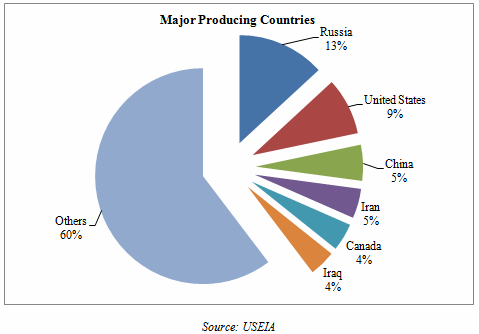|
|
Crude Oil |
||||||||||||||||||||||||||||||||||||||||||||||||
| 12 June 2014 12:06 PM | ||||||||||||||||||||||||||||||||||||||||||||||||
 | ||||||||||||||||||||||||||||||||||||||||||||||||
|
Petroleum, also called crude oil, is the most widely used non-renewable energy. It is a fossil fuel available in the earth’s crust and is used for producing a number of products such as petrol or gasoline, solvents, plastics etc., Petroleum name was derived from the words petra and oleum means rock and oil respectively. It is often referred as black gold.
Crude oil is a dark brown to greenish liquid found in the porous rocks formations in the earth. The first oil wells were reported to have drilled in China in the 4th Century. However, the commercial production of petroleum was only started in 1840s. At present crude oil accounts for about one third of world energy consumption.
Important Uses
Petroleum is a source of a number of products.
Petrol or gasoline: Major fuel energy source.
LPG: Liquefied Petroleum Gas for cooking.
By-products: Naphtha, kerosene, lubricants, asphat, ethylene, propylene, butane, benzene, ammonia, methanol, plastics, synthetic rubber, detergents and chemical fertilizers.
Production Process:
Petroleum is extracted through oil drilling after exploration and identification of reservoirs. The petroleum is then refined and separated by boiling point into a number of products such as petrol, kerosene, asphalt, plastics etc.,
Types of crude: Crude is of different types based on different characteristics.
· Based on origin it is called West Texas Intermediate (WTI) or Brent or Middle East.
· Based on relative weight or viscosity it is called light, intermediate or heavy.
· Based on sulphur content it is called sweet or sour.
Mainly two qualities that determine the value are density, which is measured in terms of America Petroleum Institute gravity (API) and sulphur content.
West Texas Intermediate (WTI): This is the largest traded crude oil in the world and benchmark in the U.S. It has 37 to 42 degrees API gravity and a sulphur content of about 0.42%.
Brent crude: It is a benchmark for Europe and Africa and is the second largest traded crude oil in the world. It has API gravity of 39 degrees and about 0.4% of sulphur.
Middle East sour crude: It has a very large physical in gulf region and Indian refineries largely benchmark against this crude. It has 31 to 37 degree API gravity and about 2% sulphur and hence it is considered as heavy and sour crude.
World Scenario
World petroleum reserves are estimated at about 235 thousand million tons. Annual petroleum production of crude oil has increased at an average rate of about one per cent per annum during the 2000s and reached about 75.5 million barrels per day in 2012 as per the data released by the U.S. Energy Information Agency (USEIA).
 Major producer are Middle East, Eurasia, North America and Saudi Arabia. Among individual countries, Russia is the largest producer of crude accounting for about 13% followed by U.S. with 9%, China & Iran with 5% each and Canada & Iraq with 4% each to the total production of crude.
Table 1: Trends in world production, consumption and trade in petroleum (million tons)
Source: Ministry of Petroleum & Natural Gas, BP Statistical Review of World Energy
Consumption of petroleum has also increased steadily and stood at about 89 million barrels per day in 2012. The largest consumer is the U.S. with a share of about 21% followed by China with about 12% share, Japan with about 5%, India and Russia with about 4% share each.
In terms of world trade, major petroleum exporting nations are Saudi Arabia, Russia, UAE and Kuwait. On the other hand, the largest importer of petroleum is U.S. followed by China, Japan and India.
Domestic Scenario
India is the fourth largest consumer as well as importer of crude petroleum in the world. India has about 758 million tons of petroleum reserves as in 2012-13. India produced about 38 million tons of petroleum annually on average during 2010-11 to 2012-13.
Onshore production of petroleum in the country has been increasing from 2010 onwards and it accounts for about half of total petroleum production. Major producing states contributing for onshore production are Gujarat, Rajasthan, and Assam.
Table 2: Trends in domestic production, consumption and trade in petroleum (million tons)
Source: Ministry of Petroleum & Natural Gas
Petroleum consumption in India has been persistently increasing particularly for petrol and other fuel products. It has posted an annual average growth of about 8% per annum from 2005-06 to 2012-13. Domestic production meets only for about 18% of total consumption.
Major Markets
Spot markets: Mumbai, Delhi, Chennai and Kolkata
Futures markets:
International: Nymex
Domestic: MCX and NCDEX
External Trade
India is a net importer as the domestic production meets only 17 to 18% of domestic consumption requirements. More than 80% of the domestic demand for petroleum is met through imports. As a result, imports of petroleum have been increasing at an average annual growth rate of about 10% per annum between 2005-06 and 2012-13.
Although India has been a net importer of petroleum, it is a net exporter of petroleum products. India exports large quantities of refined petroleum products and stands in the fourth place in world with an annual export of about 60 to 64 million tons.
Factors Influencing Prices
· Estimates of OPEC on Production, supply, stocks and spare capacities.
· Change in demand and supply conditions of major suppliers as well as consumers.
· Crude oil production and inventory positions in U.S.
· Global socio-political and economic situations
· Weather condition in the producing as well as consumer countries.
· Economic growth performance of emerging market economies (EMEs). |
Copyright © CC Commodity Info Services LLP. All rights reserved.

